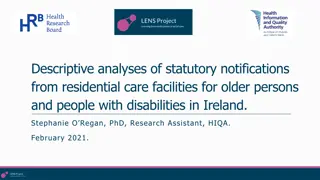
Climate Adaptation and Land Use Change
This multimedia presentation delves into the dynamics of climate adaptation and land use change, focusing on vulnerability assessments, conservation strategies, and governance structures at a regional scale. It explores past, present, and projected future scenarios while emphasizing the importance of informed decision-making and collaborative efforts.
Download Presentation

Please find below an Image/Link to download the presentation.
The content on the website is provided AS IS for your information and personal use only. It may not be sold, licensed, or shared on other websites without obtaining consent from the author. If you encounter any issues during the download, it is possible that the publisher has removed the file from their server.
You are allowed to download the files provided on this website for personal or commercial use, subject to the condition that they are used lawfully. All files are the property of their respective owners.
The content on the website is provided AS IS for your information and personal use only. It may not be sold, licensed, or shared on other websites without obtaining consent from the author.
E N D
Presentation Transcript
and Landuse Change!
Existing Landuse Possible Futures Scenario 1 Scenario 2 Scenario 3 Projected Landuse 1 Projected Landuse 2 Projected Landuse 3 Vulnerability Assessment Focal species or process
Housing Density + Energy Development (Conservative) Projected Landuse 1 Housing Density + Energy Development (Aggressive) Projected Landuse 2 Buffered Core Areas (using Wade 2011) Projected Landuse 3
1. Define Climate Adaptation Networks Regional Context 2. Identify Conservation Targets 3. Conduct Vulnerability Assessments 7. Monitor, Review, Revise 4. Identify Adaptation Options 6. Implement Management Protect current biodiversity Protect future biodiversity Maintain ecological processes Maintain/restore connectivity Protect climate refugia Protect landscape features 5. Conduct Risk Assessment Feasibility Expense Robustness to uncertainty Timeframe of impacts Consistency with policy Stakeholder buy in
Heller (2009): #1 theme the need for regional institutional coordination for reserve planning and management and to improve connectivity Engage in regional, multi-ownership planning to make adaptive actions more effective (Spies, et al. 2010)
Demonstrate how vulnerability assessments can inform spatially-explicit adaptation options at a regional (and thus cross- jurisdictional) scale Maximize the match between adaptation options and management mandates Identify low-hanging fruit and areas of mis-match Given mis-matches, what governance structures and/or policies may be meaningful or needed at the regional level?
Questionnaire for LCC-VP Collaborators 1. Describe your level of knowledge about past change climate and land use from 1900 to present and about projected future climate and land use to 2100 . 2. What is your current approach to managing natural resources under climate and land use change? List 3-5 of the key steps you use to go from identifying potential conservation concerns to implementing management to alleviate concerns for high priority issues? 3. Do you currently have the data and decision support tools necessary to execute these steps? 4. What are the major conceptual challenges you face in executing these steps? 5. What additional resources (concepts, data, and/or tools) would improve your ability to manage under climate and land use change?



